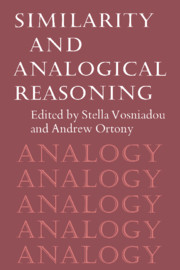Book contents
- Frontmatter
- Contents
- Preface
- List of contributors
- Similarity and analogical reasoning: a synthesis
- Part I Similarity and the structure of concepts
- Part II Analogical reasoning
- 7 The mechanisms of analogical learning
- 8 A computational model of analogical problem solving
- 9 Use of analogy in a production system architecture
- 10 Toward a microstructural account of human reasoning
- 11 Analogy and the exercise of creativity
- 12 Comments on Part II: Levels of description in information-processing theories of analogy
- 13 Comments on Part II: The role of explanation in analogy; or, The curse of an alluring name
- Part III Similarity and analogy in development, learning, and instruction
- Afterword: Comments on Parts I, II, and III: A framework for a theory of comparison and mapping
- Name index
- Subject index
11 - Analogy and the exercise of creativity
Published online by Cambridge University Press: 22 October 2009
- Frontmatter
- Contents
- Preface
- List of contributors
- Similarity and analogical reasoning: a synthesis
- Part I Similarity and the structure of concepts
- Part II Analogical reasoning
- 7 The mechanisms of analogical learning
- 8 A computational model of analogical problem solving
- 9 Use of analogy in a production system architecture
- 10 Toward a microstructural account of human reasoning
- 11 Analogy and the exercise of creativity
- 12 Comments on Part II: Levels of description in information-processing theories of analogy
- 13 Comments on Part II: The role of explanation in analogy; or, The curse of an alluring name
- Part III Similarity and analogy in development, learning, and instruction
- Afterword: Comments on Parts I, II, and III: A framework for a theory of comparison and mapping
- Name index
- Subject index
Summary
Introduction
Analogies are tools for thought and explanation. The realization that a problematical domain (the target) is analogous to another more familiar domain (the source) can enable a thinker to reach a better understanding of the target domain by transporting knowledge from the source domain. A scientific problem can be illuminated by the discovery of a profound analogy. A mundane problem can similarly be solved by the retrieval of the solution to an analogous problem. An analogy can also serve a helpful role in exposition: A speaker attempting to explain a difficult notion can appeal to the listener's existing knowledge by the use of an analogy. A psychological theory of analogies must accordingly account for three principal phenomena: (a) the discovery or retrieval of analogies of various sorts from the profound to the superficial, (b) the success or failure of analogies in the processes of thinking and learning, and (c) the interpretation of analogies that are used in explanations.
My main purpose in this chapter is to establish that psychological theories of analogy have so far failed to take the measure of the problem. The processes underlying the discovery of profound analogies are much harder to elucidate than is generally realized. Indeed, I shall argue that they cannot be guaranteed by any computationally tractable algorithm. But my goals are not entirely negative; I want to try to establish a taxonomy of analogies and to show that there are some forms of analogy that can be retrieved by tractable procedures. I shall begin with an area that has undergone considerable psychological investigation: the role of analogies in problem solving.
- Type
- Chapter
- Information
- Similarity and Analogical Reasoning , pp. 313 - 331Publisher: Cambridge University PressPrint publication year: 1989
- 38
- Cited by



